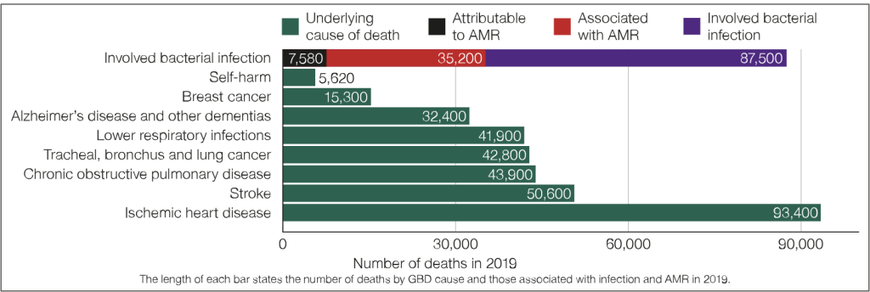World AMR Awareness Week (WAAW) 2025: 18 to 24 November
Antimicrobial resistance (AMR) represents a major global threat across human, animal, plant, food, and environmental sectors.
In 2019, it was estimated that almost 5 million deaths globally were associated with bacterial AMR, including 1.27 million deaths being directly caused by it. The image below published in the Confronting antimicrobial resistance 2024 to 2029 shows that 87,500 deaths in the UK in 2019 involved a bacterial infection and 35,200 associated with AMR.
Impact of infection and AMR in the UK
What are antimicrobials?
Antimicrobials – including antibiotics, antivirals, antifungals and antiparasitics – are medicines used to prevent and treat infections in humans, animals and plants.
What is antimicrobial resistance?
Antimicrobial Resistance (AMR) occurs when bacteria, viruses, fungi and parasites change over time and no longer respond to medicines making infections harder to treat and increasing the risk of disease spread, severe illness and death.
As a result of drug resistance, antibiotics and other antimicrobial medicines become ineffective and infections become increasingly difficult or impossible to treat.
AMR occurs when bacteria, viruses, fungi and parasites change over time and no longer respond to medicines, making infections harder to treat and increasing the risk of disease spread, severe illness and death. As a result of drug resistance, antibiotics and other antimicrobial medicines become ineffective and infections become increasingly difficult or impossible to treat.
This year's theme
The overall theme for World AMR Awareness Week (WAAW) 2025 is “Act now: Protect Our Present, Secure Our Future.”
Below are various themes for each of the 5 weekdays in WAAW
The themes have also been mapped to highlight which of the 2024 to 2029 national action plan on AMR they align to.
Day 1: ‘Prevention’ theme (including infection prevention and control measures and vaccination). This themes links to outcome 1 (infection prevention and control and infection management) of the NAP.
Watch Eve Spiers, Lead Nurse for Infection Control explain more in the video below:
Day 2: ‘Antimicrobials in clinical practice’ theme (for example consider audits on or promoting good practice for antibiotic course length, promoting shorter course length, empiric prescribing, intravenous-oral switch, promotion of current clinical guidelines). This theme links to outcome 4 (antimicrobial stewardship and disposal) of the NAP.
Watch Robert Jackson, Consultant Microbiologist explain more in the video below:
Day 3: Intravenous to oral antibiotics switch (on average, approximately 20 – 25% of hospital inpatients are being treated with IV antibiotics at any one time. A recent GHT trust wide audit identified that approximately one third of patients audited on IV antibiotics could have been switched to oral appropriately and safely.
Some antibiotics have excellent oral bioavailability and could be used for more some severe infections if clinically appropriate. See attached oral bioavailability of common antibiotics poster. This is also accessible via EOLAS.
Watch Alice Liu, Antimicrobial Pharmacist explain more in the video below:
Day 4: Health inequalities – this focus on the health inequalities
This focuses on the increased risk of AMR in patients who experience health inequalities e.g elderly population, patient with confusion or dementia, language barriers.
This theme links to Outcome 8 (Health disparities and health inequalities) of the NAP.
Watch Edward Moseley, Consultant in Infection explain more in the video below:
Day 5: AMS in paediatrics
This theme links to Outcome 8 (Health disparities and health inequalities) of the NAP.
Paediatric IVOS Guidance & Tablet-Swallowing Resources – Now Live
We’re pleased to share the launch of the UKHSA Paediatric IVOS decision aid, supporting safe and effective intravenous-to-oral antibiotic switches in children on the EOLAS platform.
IVOS is a key antimicrobial stewardship intervention with proven benefits:
- Reduced infection risk of bloodstream and catheter-related infections
- To free up nursing time
- Lower cost of consumables
- Reduced carbon footprint
- Facilitates earlier discharge
- Improved patient experience
Supporting Children to Swallow Tablets
Explore these practical resources Medicines For Children and Kidzmed (NHSE)to help children learn to swallow tablets.
Caring for children with coughs this winter
Coughs and colds are a common part of childhood, especially during the winter. Most of these infections are caused by viruses and children recover quickly with a bit of rest and paracetamol.
However, many parents of young children can be very worried when their children are unwell and would welcome support and guidance on what to do and when to seek help.
A simple tool has been developed that can help navigate parents through these worries. The Caring for children with cough leaflet was produced by researchers at the University of Bristol after extensive work with parents. It explains what parents should do when looking after a child with cough and when parents should take their child to see a doctor. This leaflet is in routine use by local NHS services.
WAAW resources
- Find out more about World AMR Awareness Week and Antimicrobial Resistance
- Everybody can pledge to become an Antibiotic Guardian including families and educators:
- You can also access a whole host of educational resources aligned to the national curriculum at eBug.
